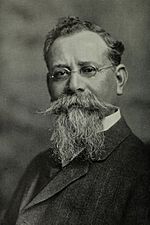Plan of Guadalupe facts for kids

The Plan of Guadalupe (Spanish: Plan de Guadalupe) was a political manifesto which was proclaimed on March 26, 1913, by the Governor of Coahuila Venustiano Carranza in response to the reactionary coup d'etat and execution of President Francisco I. Madero, which had occurred during the Ten Tragic Days of February 1913. The manifesto was released from the Hacienda De Guadalupe, which is where the Plan derives its name, nearly a month after the assassination of Madero. The initial plan was limited in scope, denouncing Victoriano Huerta's usurpation of power and advocating the restoration of a constitutional government. In 1914, Carranza issued "Additions to the Plan of Guadalupe", which broadened its scope and "endowed la Revolución with its social and economic content." In 1916, he further revised the Plan now that the Constitutionalist Army was victorious and revolutionaries sought changes to the 1857 Constitution of Mexico. Carranza sought to set the terms of the constitutional convention.
Background
Carranza was a dedicated supporter of fellow Coahuilan Francisco I. Madero. Huerta's "military dictatorship, notable for political corruption and rule by imprisonment and assassination" juxtaposed the formerly "liberal" government which he was appointed the minister of war in Madero's Revolutionary cabinet. Although there had been scattered rebellions against Huerta, there was no unified plan for the revolutionaries. Carranza was one of the most prominent and well-known opposers of Huerta: he was the then-sitting governor of the state of Coahuila. His plan initially united anti-Huerta forces in his home state, but other revolutionary groups signed onto it. "The plan became the official program of the northern revolutionaries. It was subscribed to by leading figures of the Mexican Revolution such as Pancho Villa, Álvaro Obregón, and Felipe Ángeles. One scholar has called the plan "oft-mentioned and highly overrated," but the plan did attract widespread support for the anti-Huerta coalition, despite its solely political demands. In December 1914, Carranza issued "Additions to the Plan of Guadalupe", which directly addressed land reform and reforms to improve the lives of workers and peasants.
Description of the Plan
The Plan was divided into seven statements which aimed to repudiate the legitimacy of Huerta's government. The statements reject Huerta as president, including the legislative and judicial branches and any state supporting his administration. The plan designates the collective the northern revolutionary forces, the Constitutionalist Army. It was to be recognized as a legitimate military force, with Carranza as "First Chief" (Primer Jefe). This articulated Carranza's belief that "the only way the revolutionaries would ever be able to maintain themselves in power was by destroying the old federal army." The plan gave Carranza interim power over Executive Power until peace was restored and then call for new elections.
Ship name
The former USS Dolphin (PG-24) was acquired by Mexico on 25 February 1922 and renamed the Plan de Guadalupe, serving until circa 1927.
See also
 In Spanish: Plan de Guadalupe para niños
In Spanish: Plan de Guadalupe para niños

